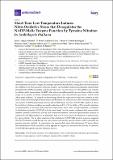Por favor, use este identificador para citar o enlazar a este item:
http://hdl.handle.net/10261/193483COMPARTIR / EXPORTAR:
 SHARE SHARE
 CORE
BASE CORE
BASE
|
|
| Visualizar otros formatos: MARC | Dublin Core | RDF | ORE | MODS | METS | DIDL | DATACITE | |

| Título: | Short-term low temperature induces nitro-oxidative stress that deregulates the NADP-Malic enzyme function by tyrosine nitration in arabidopsis thaliana |
Autor: | Begara Morales, Juan Carlos; Sánchez-Calvo, Beatriz CSIC ORCID CVN; Gómez-Rodríguez, María V.; Chaki, Mounira CSIC ORCID; Valderrama, Raquel; Mata-Pérez, Capilla; López-Jaramillo, Javier CSIC ORCID; Corpas, Francisco J. CSIC ORCID; Barroso-Albarracín, Juan Bautista CSIC ORCID | Palabras clave: | NADP malic enzyme Low temperature Nitric oxide tyrosine nitration Peroxynitrite Reactive oxygen species Reactive nitrogen species Nitro-oxidative stress |
Fecha de publicación: | 1-oct-2019 | Editor: | Multidisciplinary Digital Publishing Institute | Citación: | Antioxidants 8(10): 448 (2019) | Resumen: | Low temperature (LT) negatively affects plant growth and development via the alteration of the metabolism of reactive oxygen and nitrogen species (ROS and RNS). Among RNS, tyrosine nitration, the addition of an NO2 group to a tyrosine residue, can modulate reduced nicotinamide-dinucleotide phosphate (NADPH)-generating systems and, therefore, can alter the levels of NADPH, a key cofactor in cellular redox homeostasis. NADPH also acts as an indispensable electron donor within a wide range of enzymatic reactions, biosynthetic pathways, and detoxification processes, which could affect plant viability. To extend our knowledge about the regulation of this key cofactor by this nitric oxide (NO)-related post-translational modification, we analyzed the effect of tyrosine nitration on another NADPH-generating enzyme, the NADP-malic enzyme (NADP-ME), under LT stress. In Arabidopsis thaliana seedlings exposed to short-term LT (4 °C for 48 h), a 50% growth reduction accompanied by an increase in the content of superoxide, nitric oxide, and peroxynitrite, in addition to diminished cytosolic NADP-ME activity, were found. In vitro assays confirmed that peroxynitrite inhibits cytosolic NADP-ME2 activity due to tyrosine nitration. The mass spectrometric analysis of nitrated NADP-ME2 enabled us to determine that Tyr-73 was exclusively nitrated to 3-nitrotyrosine by peroxynitrite. The in silico analysis of the Arabidopsis NADP-ME2 protein sequence suggests that Tyr73 nitration could disrupt the interactions between the specific amino acids responsible for protein structure stability. In conclusion, the present data show that short-term LT stress affects the metabolism of ROS and RNS, which appears to negatively modulate the activity of cytosolic NADP-ME through the tyrosine nitration process. | Versión del editor: | https://www.mdpi.com/2076-3921/8/10/448 | URI: | http://hdl.handle.net/10261/193483 | DOI: | 10.3390/antiox8100448 | E-ISSN: | 2076-3921 |
| Aparece en las colecciones: | (EEZ) Artículos |
Ficheros en este ítem:
| Fichero | Descripción | Tamaño | Formato | |
|---|---|---|---|---|
| Short_Term_Bergara_Art2019.pdf | 2,31 MB | Adobe PDF |  Visualizar/Abrir |
CORE Recommender
PubMed Central
Citations
9
checked on 10-abr-2024
SCOPUSTM
Citations
18
checked on 13-abr-2024
WEB OF SCIENCETM
Citations
14
checked on 27-feb-2024
Page view(s)
216
checked on 16-abr-2024
Download(s)
196
checked on 16-abr-2024

